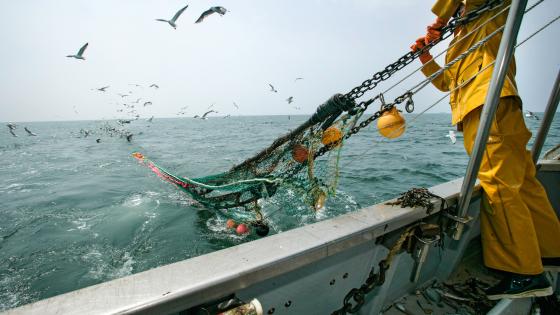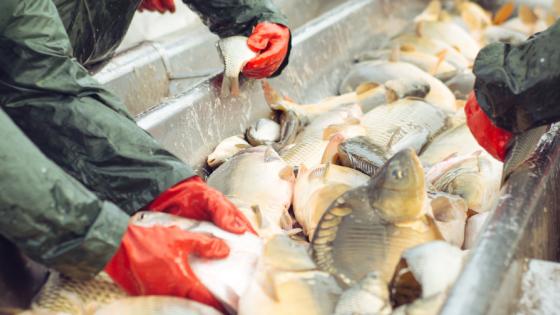Despite its marginal size in economic statistics,
the fishing industry has a far-reaching impact on the conditions of life on the planet due to overfishing and destructive fishing techniques. This is the message of many documentaries, newspaper articles, and scientific papers (e.g. Kim Taveras and Armand 2021, McCauley et al. 2015, KRO-NCRV 2023).
Economists are familiar with this problem – every welfare economics textbook discusses the tendency to overexploit natural resources – but research on how this natural resource is harvested and how to address overfishing rarely appears in economics journals. The focus of most economists tends to be on the analysis of markets and, more broadly, human interaction given the supply of natural resources such as fish and given the dumping, discharging, or burning of waste streams. Some recent exceptions within the context of fishing include Jacques et al. (2019), Gonzalez-Lira and Mobarak (2021), Kroetz et al. (2022), and Frank and Oremus (2023).
In our study (Kastoryano and Vollaard 2023), we use the tools of forensic economics to uncover how a natural resource – fish – enters the economic system. We study North Sea sole targeted by Dutch cutters, which is sold across Europe as sustainable seafood under the ecolabel of the Marine Stewardship Council (MSC). According to the MSC (2023), “sustainable seafood comes from fisheries that catch fish in ways that ensure the long-term health of a stock or species and the wellbeing of the ocean”. However, the MSC does not actively monitor compliance. Based on landed catch data, we reconstruct what actually happens at sea.
Getting everything out of a haul
We focus on compliance with minimum mesh size regulation for fishing nets. Naturally, fishers want to maximise the catch from each haul. The smaller the mesh size, the fewer fish of a marketable size escape the net. However, smaller mesh sizes also increase the catches of fish below marketable size. Figure 1 shows the distribution of the catch of sole by size (length in cm). The shaded area reflects the additional catch of under-sized fish due to fishing with 40mm rather than 80mm-sized mesh. The under-sized fish cannot be sold and are therefore discarded at sea, either dead or with little chance of survival.
Figure 1 Smaller mesh size mainly increases bycatch of under-sized sole
Source: Adapted from Molenaar and Chen (2018).
Ideally, fishers will leave some of the juvenile fish untouched to ensure the survival of the species. This is the case when they comply with the legal minimum mesh size (8cm for North Sea sole). Even then, easily half of the catch consists of juvenile fish and other ‘bycatch’ such as skates, rays, sharks, sea slugs, and starfish. Fishers are regularly tempted to reduce mesh size below 8cm in hard-to-discover ways such as ‘liners’ (in which lines are woven through a legal net), or ‘blinders’ (using a legal net within another legal net). Both methods roughly halve the mesh size. To date, all that we know about this fraud is based on anecdotal evidence and very rare detections.
Exploiting variation in the incentive to comply
There is always a challenge to studying fishing fraud, in that fishers’ behaviour is difficult to monitor. Patrol vessels must cover vast areas of sea, and inspections are typically anticipated by fishers. On top of that, inspections of catches in port only reveal so much of what happened at sea. A fishing vessel may land lots of bycatch, for instance, as a result of using legal nets.
Thus, we needed a different way of detecting illegal fishing practices. Our approach builds on the finding from fishing research expeditions that the use of illegal small-mesh nets distinctively alters the composition of the landed catch. Illegal nets skew the size distribution of landed fish, with a disproportionate share of small fish relative to medium and large fish (Molenaar and Chen 2018). We can use this fact to track the presence of illegal activity, provided that it is more likely to occur in certain situations than in others.
In our study, we use quasi-random variation in the deployment of the single Dutch inspection vessel in the North Sea as a shock to fishing vessels’ compliance incentives. We take advantage of the fact that during some intervals – due to vacations, international engagements, or maintenance – the inspection vessel takes full weeks off patrolling. This allows us to identify the strategic use of illegal nets by comparing the size distribution of landed fish in patrolled versus non-patrolled adjacent weeks.
Large increase in bycatch of juvenile fish
We find that in weeks during which the inspection vessel is patrolling at sea, the share of small fish in the landed catch is significantly lower than in adjacent weeks with no patrolling. We also find that the absence of patrol goes together with declines in the catch of large fish, a tell-tale sign of a common way to restrict mesh size.
Our results indicate that this strategic behaviour is widespread, with about 14% of the fishing vessels in our sample induced to use illegal nets when the inspection vessel is absent, affecting about 18% of the landed catch of small sole. This effect comes in addition to the illegal behaviour that is not affected by variation in deployment of the inspection vessel. Since the inspection vessel patrols a huge sea area, this baseline level of noncompliance is likely to be non-negligible.
Our data allow us to assess the environmental harm of the illegal practice in terms of discarded bycatch. The additional catch and discard of individual undersized sole resulting from this strategic behaviour of fishermen is approximately 17 times greater than the additional catch of individual adult sole during the 19 weeks per year, on average, with no patrols. The illegal practice also affects the bycatch of other species. We approximate the additional catch and discard of undersized individual plaice to be 23 times greater than the additional catch of individual adult sole.
It should be noted that these are only the static losses associated with this practice. Considering that juvenile sole and plaice would start to reproduce two to three years later if not caught, the losses are many times larger when considered within a longer time window.
Response
The industry did not dispute the findings of our study. “I understand the short-term interests at play here, but this way we lose understanding of the industry. Monitoring compliance is proving to be incredibly difficult: how can we adequately stop this?”, the chairman of the Dutch Fishermen’s Union told a Dutch newspaper in response to our findings (Olthuis 2022).
The newspaper report led members of parliament to question the Minister of Agriculture, Nature and Food Quality. He replied that it was a difficult issue: “It remains a challenge to detect violations because fishermen have to be caught in the act . . . Fishermen can see patrol vessels approaching from afar”. The minister hopes that aerial surveillance and cameras on board of fishing vessels will make a difference in the future, but also “appeals to the industry to take its responsibility to increase compliance with laws and regulations” (Dutch Parliament 2023).
Our paper shows numerous improper activities that occur before fish enter the economic system. The harm that we have uncovered has thus far been largely ignored in estimates of the externalities of fishing, and may have escaped the attention of the Marine Stewardship Council. Our findings raise questions as to whether the fishers in this industry deserve the MSC label on their products.
References
Dutch Parliament (2023), “Kamervraag 2023Z07888”, The Hague, 4 July.
Frank, E and K Oremus (2023), “Regulating Biological Resources: Lessons from Marine Fisheries in the United States”, Working paper no. 63, Energy Policy Institute, University of Chicago.
Gonzalez-Lira, A and M Mobarak (2021), “Slippery Fish: Enforcing Regulation when Agents Learn and Adapt”, NBER Working Paper 28610.
Jacques, J-F, B Copeland, M Fugazza and B Bayramoglu (2019), “Trade and negotiations on fisheries subsidies”, VoxEU.org, 21 October.
Kastoryano, S and B Vollaard (2023), “Unseen annihilation: Illegal fishing practices and nautical patrol” , Journal of Environmental Economics and Management 122: 102881.
Kim Taveras, I and A Armand (2021), “Harming the ocean impacts children in low- and middle-income countries”, VoxEU.org, 11 April.
KRO-NCRV (2023), “Sliptong”, Keuringsdienst van Waarde, episode 23: 11, 2 May.
Kroetz, K, L Nøstbakken and M Quaas (2022), “The Future of Wild-Caught Fisheries: Expanding the Scope of Management”, Review of Environmental Economics and Policy 16(2): 241–61.
McCauley, D J, M L Pinsky, S R Palumbi, J A Estes, F H Joyce and R R Warner (2015), “Marine defaunation: animal loss in the global ocean”, Science 347(6219): 1255641.
Molenaar, P and C Chen (2018), “Cod-End Selectivity for Sole (Solea Solea) and Plaice (Pleuronectes Platessa) in North Sea Pulse-Trawl Fisheries”, report C049/18, Wageningen Marine Research.
MSC (2023), “What does the blue MSC label mean?”, msc.org, accessed 9 October.
Olthuis, L (2022), “Nederlandse vissers gebruiken illegale netten om extra sliptong te vangen”, de Volkskrant, 29 September.




